
Trumpeter 1/48 Wellington IIC
| KIT #: | 02808 |
| PRICE: | CDN$66.00 SRP |
| DECALS: | Three options |
| REVIEWER: | Pablo Calcaterra |
| NOTES: | Alley Cat conversion kit 48003C (to MkII) and 48004C (4,000 lb bomb and cradle) |

| HISTORY |
This build has a very special personal significance: it represents the plane flown by Jacek (Jacek) Blocki (my brother in law’s uncle) during the mission that earned him his Polish Virtuti Militari class V (5) cross.
Jacek was born in
After several adventures walking under the summer sun
and with Rafal’s ankle injured and thus not able to continue with them (he was
picked by a truck and eventually also escaped
Interned in a refugee camp in Targoviste it became
clear that there would be no support from
Their next destination, which
he reached by ship, was
The POLONAISE 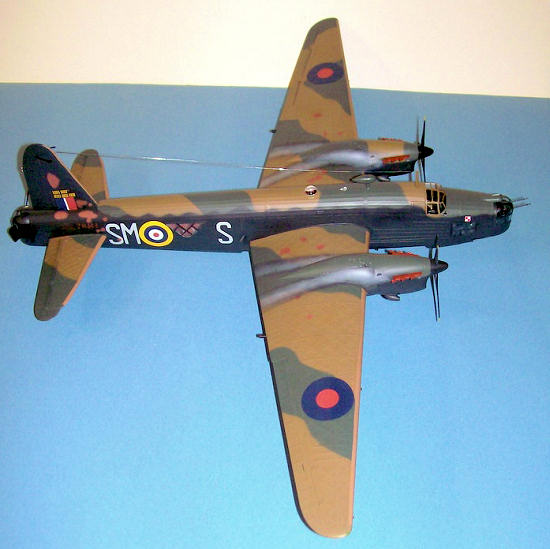 adventures,
close calls, escaping from French officers who wanted to seize them, lack of
French help (military, police or civilian) and much hunger they were able to
reach St. Jean de Luz (one kilometer away from Spain). To their great delight
the Andorra Starr, the last ship sent to pick up British Consulate staff and
stragglers was there. The initial refusal to help from the French was overcome
by the strong attitude of 6 Royal Marines and some money…that derived into
sudden change of attitude and the now friendly small fishing boats transported
the troops from the shore to the awaiting old ship.
adventures,
close calls, escaping from French officers who wanted to seize them, lack of
French help (military, police or civilian) and much hunger they were able to
reach St. Jean de Luz (one kilometer away from Spain). To their great delight
the Andorra Starr, the last ship sent to pick up British Consulate staff and
stragglers was there. The initial refusal to help from the French was overcome
by the strong attitude of 6 Royal Marines and some money…that derived into
sudden change of attitude and the now friendly small fishing boats transported
the troops from the shore to the awaiting old ship.
On June 23rd
Jacek and his friends arrived in
First Tour of Operations:
Finally, in May 1942 he and his crew of Sergeants (except for Prot, the navigator, who was an Officer and had been a member of the Polish Air Force) were posted to B Flight 305 Polish Bomber Squadron in Lindholme, where they arrived the day after the first 1,000-bomber raid.
They were assigned a plane (Wellington MkII Z8343 - S
for Sugar) and Flying Officer Jan Borowski as screen pilot. On June 20th,
they undertook their first mission when they bombed
From then onwards the missions with Jan as screen pilot were as follows:
|
Date
(1943) |
Target |
|
June 22nd |
|
|
June 23rd |
St.
Nazaire |
|
June 25th |
|
|
July 2nd |
|
|
July 7th |
Gardening |
|
July 8th |
Willhelmshaven |
|
July 13th |
|
|
July 25th |
|
|
July 26th |
|
|
July 29th |
|
This was the mission that earned him the Virtuti Militari and this is what happened:
Flying at around 16,000 ft approximately 200 bombers made it to the target area, which was supposed to be defended only by light flak. Suddenly all hell let loose and 88 mm shells illuminated the sky around the bombers. The searchlights captured one of the planes that, hit, started to fall engulfed in flames and smoke. At that moment S for Sugar was hit by a powerful explosion that left her flying in a strange angle and with the fuselage and wings fabric full of holes. Stephan the bomb aimer was not answering. Jacek dropped the bombs and turned sharply to return home. Another 88 bright explosion under the nose damaged the left engine, which started to run very noisily. The rev counter spinned twice around. The entire plane shook for some seconds and a more violent shudder marked the fall of the left propeller. Jacek told his crew to don the parachutes but not jump until he told them so. Commenting on the status of the plane on the intercom he asked Prot for a course to reach the coast as soon as possible while loosing height to gain some speed and leave the area.
Doing 150 mph the plane was flying fine but was
loosing height. When the Dutch coast was reached they had dropped to 7,000 feet
and Jacek stopped the descent. On only the right engine and with rudder fully
deployed to compensate the torque the plane now was doing only 100 mph and felt
wooly. The time to make the decision was reached and he consulted the crew:
Should they keep on going and risk ditching in the
Thirty minutes later and with Henryk the wireless operator prostrated below helping Jacek’s right foot to keep a steady pressure on the rudder Piotr came out from the nose turret. Stefan’s (bomb aimer) flying Jaceket was covered in blood. Piotr and Prot found that Stefan had a 2 inch cut behind this ear and that was the reason why he would not answer the calls in the intercom: his wiring had been severed.
It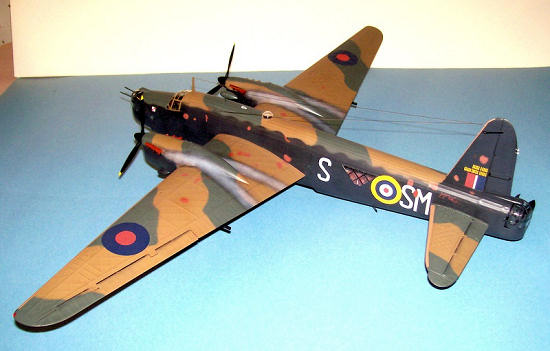 was
was
Upon inspection of the plane it was discovered that it
had 33 holes, the reduction gears in front of the port engine had disintegrated
the main casing and the propeller was lost. Lady Luck had stayed with them
because the engine should had caught fire…or should the propeller had not been
lost the extra drag would not had allowed them to “glide” back to
Prot’s stomach ulcer finally surfaced and along with the injured Stefan he never flew again. For his skills and courage in this mission Jacek was awarded the Virtuti Militari Cross (Class V - Silver) in September 1943.
After a leave Jacek flew again S for Sugar on two occasions at the end of August but did not participate in an operation during that month. On September 1st, with some new crewmembers, Jacek flew the next mission (from now on, on Wimpys MkIV with American radial engines)
|
Date
(1943) |
Target |
|
September 1st |
|
|
September 2nd |
Karlsruhz |
|
September 3rd |
|
|
September 6th |
|
|
September 14th |
Willhelmshaven |
|
October 8th |
Q-site recognition |
|
October 15th |
|
|
October 31st |
Gardening |
|
November 7th |
Gardening |
|
November 9th |
|
|
November 20th |
Turin (taking off from Tangmere) |
|
November 25th |
Essen |
|
November 28th |
Gardening |
|
December 11th |
Gardening |
|
December 14th |
Gardening |
|
December 19th |
Gardening |
|
December 31st |
Gardening |
|
1943 |
|
|
January 2nd |
Gardening |
|
January 3rd |
Gardening |
|
January 8th |
Gardening |
|
January 9th |
Gardening |
During the mission to Hamburg on November 9th, and after an uneventful bombing run when they dropped another 4,000 lb cookie, the crew now flying in Wellington MkIV Z1496 headed for the North Sea. The gunners were congratulating themselves for another good mission when, without warning from the tail gunner two white tracers shot past both sides of the fuselage level with the cockpit and dipped ahead out of sight. A shout (“Christ!”) meant that someone had been hit. Jacek pushed the column to the forward to the right and descended aggressively towards the clouds 5,000 ft below. At the same time a Ju88 passed overhead on a steep left turn. Jacek sent a crewmember to check the status of Kazik the tail turret gunner. He was brought forward, uninjured, but stammering with wide-open eyes fixed into space. One shell had hit the turret 2 inches above Kazik’s head. By the time they had landed the gunner had recovered most of his composure, was taken to sick quarters and after 48hs he informed Jacek that he was not going to get into a Wellington ever again. He was posted away with LMF (Lack of Moral Fibre) and he finished the war as a cook in an airman’s mess.
Terrible losses suffered by 305 Sqn meant that the last part of Jacek’s tour was gardening…that is to say dropping mines in front of France. This was a very special type of mission that required very precise navigation at very low height at night.
During one of these missions
Jacek’s screen pilot during the first combats (F/O Borowski) was lost. His
Wellington
W5526 (SM-J)
was hit by flak off Brest on August
20th.
They ditched in
the sea, got in the dinghy and in the morning a French fishing boat rescued
them. The asked the Frenchman to take them to England but he answered that the
Germans were watching from the coast and if he failed to bring them to France
his family would suffer the consequences. Therefore the
crew was taken
POW with Sgt. Raginis managing to escape from the prisoner camp in Poland and
eventually made his way back to the UK via France and Spain.
The last two original members of his crew (Piotr and Henryk) were lost without a trace while on loan to another crew during a mission to Germany early November 1942.
During the time Jacek flew with 305 Sqn 15 crew were lost in combat. The cold numbers show that
|
Year |
Number of Wellingtons lost |
|
1941 |
15 |
|
1942 |
26
(*) |
|
1943 |
8 |
(*) 11 lost before the end of May (when Jacek joined 305 Sqn) .
It was a terrible attrition rate that left the squadron decimated.
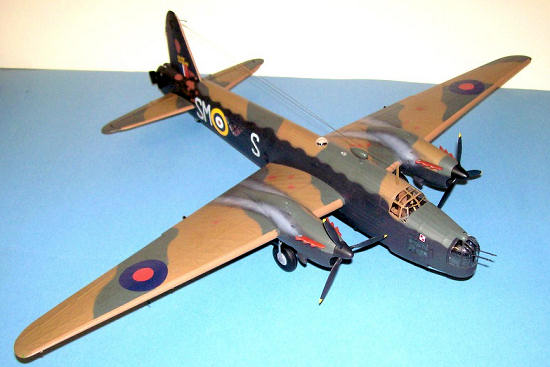 After
completing his first tour of Operations (30 missions) Jacek was sent to 18
O.T.U. as an instructor until August 1943. Then he was sent to a Flying
Instructors course (No2 FIS Montrose). Here he met some old friends from his
escape from Poland who now were in the process of starting or completing the
course. On December 13th 1943 Jacek
married Hilda with Rafal as his best man (his brother was serving in the Army –
he later fought in Monte Cassino).
After
completing his first tour of Operations (30 missions) Jacek was sent to 18
O.T.U. as an instructor until August 1943. Then he was sent to a Flying
Instructors course (No2 FIS Montrose). Here he met some old friends from his
escape from Poland who now were in the process of starting or completing the
course. On December 13th 1943 Jacek
married Hilda with Rafal as his best man (his brother was serving in the Army –
he later fought in Monte Cassino).
Second Tour of Operations:
On January 1sts 1944 Jacek was promoted to Pilot Officer. On the following day he arrived in RAF Lyneham to fly in the now forming 1586 (P for Polish) Flight (attached to 148 Sqn RAF). This unit flew brand new B-24 (Liberator Mk VI for the British) and his Captain was Stan Szostak. In a couple of weeks they went thru the conversion process and learned how to fly the huge monsters even with their eyes closed.
On February 20th they left Lyneham for Rabat, Algier and Brindisi (their new base). Their plane was BZ965. Conditions at Brindisi (rain, mud, cold, spartan installations, bad food) meant that every minute in the plane was treasured. They’d rather stay inside the plane than walking around the base!
1586 (P) Flight had to do drops of spies, supplies and armaments at night in a wide area, from Northern Italy to Yugoslavia and Poland. Always as copilot of Stan Szostak (either on BZ860 or BZ965) the missions were as follow:
|
Date
(1944) |
Target |
|
March 11th |
Northern Italy |
|
March 13th |
Northern Italy |
|
March 17th |
Poland |
|
March 19th |
Italy |
|
March 22nd |
Northern Italy |
|
March 24th |
Yugoslavia |
|
March 28th |
Yugoslavia |
|
March 29th |
Yugoslavia |
|
April 2nd |
Yugoslavia |
|
April 3rd |
Poland |
|
April 8th |
Poland |
|
April 9th |
Poland |
|
April 12th |
Poland |
|
April 14th |
Poland |
|
April 15th |
Poland |
|
April 18th |
Yugoslavia |
|
April 22nd |
Northern Italy |
|
April 23rd |
Poland |
|
April 25th |
Northern Italy |
|
April 27th |
Poland |
|
April 29th |
Northern Italy |
|
April 30th |
Poland |
|
May 2nd |
Northern Italy |
|
May 3rd |
Northern Italy |
|
May 4th |
Poland |
|
May 10th |
Poland (returned on 3 engines) |
|
May
12th |
Poland (all mission done on 3 engines) |
|
May
16th |
Northern Italy |
|
May 19th |
Poland (plane damaged by flak) |
|
May 21st |
Poland |
|
May 28th |
Poland |
|
May 29th |
Poland – Motyln 4 |
There are 3 missions among all the 30 dangerous night flying operations that stand out:
March 22nd:
A Drop Zone (DZ) for two agents would be marked in Northern Italy using fires deployed in a Y shape after 01:00. The flight was uneventful, the DZ found on time at 8,000 ft (in the Alps area…this means that the peaks were all around them but not visible) and the containers were dropped on the mark. After doing a 180 and again with the Y still visible this time the two agents jumped from the Liberator. At that moment and looking out of the windows they saw snow covered peaks practically touching the right wing. Calling out the emergency Stan ordered Jacek to push the throttles thru the gate to Emergency Power. With both pilots pulling with all their might and the engines roaring they managed to avoid the peaks but then the plane stalled and fell 3,000 ft. Luckily for them they had fallen into the next valley…Slowly but steadily they gained height and covered in sweat and exchanging comments about how lucky they had been they started their return leg…with Stan mumbling and grumbling about the planners that had sent a Liberator to do things that only a Hurricane could…
March 24th:
During the drop mission to the North weather was very
god except for a storm front around Genoa. When they were returning at 9,000 ft
they found the same clouds with ice and turbulence. Clouds were very thick and
they could not make out the fires at Anzio. When the navigator told them they
turned to the South East for Brindisi. The cloud seemed to be thin now. Suddenly
the clouds started to get orange and they thought it was the sun rising…but two
hours too early! As minutes ticked all around the plane became a pulsating red.
This was really odd and when they were about to turn right to get out of that
eerie cloud all hell broke loose. The plane was tossed upwards, Stan was ejected
from his seat and fell to the floor, their engineer fell into the fuselage and
the plane went into an uncontrolled dive. Jacek managed to control the column
and pull up while red and orange balls were shooting up all around the plane.
The turbulence ceased the same way it had started. Blaming the navigator for a
bad 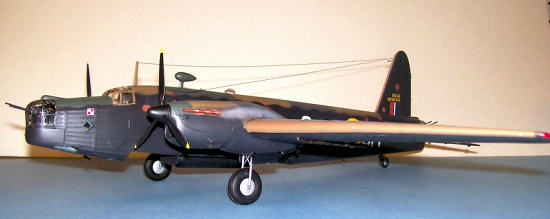 course
that had taken them over Anzio and the fury of the Allied gunners they checked
the plane. Everything was fine except for a mysterious burning smell. Air
Traffic Controller at Brindisi told them that visibility was more than 10 miles
but they could barely see the flare path 1 mile away. When they landed (still in
the middle of the night) their Ground Chief greeted them with anger. What had
they done to his plane?? All the paint on the nose and border of attack of the
wings was gone and the clear surfaces were covered in black sooth. When they
arrived to be de-briefed the intelligence officer told them that Mt. Vesuvius
had erupted. They had flown into the eruption and survived! BZ965 was up and
flying again 5 days later for yet another mission to Yugoslavia.
course
that had taken them over Anzio and the fury of the Allied gunners they checked
the plane. Everything was fine except for a mysterious burning smell. Air
Traffic Controller at Brindisi told them that visibility was more than 10 miles
but they could barely see the flare path 1 mile away. When they landed (still in
the middle of the night) their Ground Chief greeted them with anger. What had
they done to his plane?? All the paint on the nose and border of attack of the
wings was gone and the clear surfaces were covered in black sooth. When they
arrived to be de-briefed the intelligence officer told them that Mt. Vesuvius
had erupted. They had flown into the eruption and survived! BZ965 was up and
flying again 5 days later for yet another mission to Yugoslavia.
May 28th:
Jacek was summoned to the presence of Squadron Leader Krol. He was told that as his tour was about to finish he had to go to Bari to get attached to a Dakota squadron for a very confidential mission and that he could not tell anyone about it.
At Bari Jacek met Flight Lietenant Jim O’Donovan, his skipper for this special mission. On the 29th they were briefed: escorted part of the way out by two Liberators they were to land in Poland in an area between the German and Soviet troops, deliver two passengers (Lt. General Tadeusz Kossakowski (specialist in armoured warfare) and Lt. Colonel Romauld Bielski (sabotage expert) plus stores, extract 4 agents and return them to Bari. After the information and details were passed the sobered crew exchanged a few words. Operation code name was Motyl 4 (Butterfly in Polish – it was to be the 4th of these type of missions to be flown). They took off in broad daylight and flew north. By the time they had entered enemy airspace it was nighttime. With excellent navigation they arrived to a small and unused Luftwaffe airfield located between the Rivers Vistula and San and the Tatra mountains. When the members of the Home Army (AK) heard the plane doing one circuit they turned on letter T and red and green lights to mark the runway. As soon as the Dakota touched down Jacek run to the back of the plane to open the door helped by two other crewmembers. The plane came to a sudden stop with both engines idling. Pistol in hand Jacek jump out of the plane into the darkness. Grass was so tall that it almost reached his chin. Not knowing what to except next he waited for a minute. Suddenly a large figure appeared behind the tail of the plane talking in Polish: “Motyl czwarty? (Butterfly four?)”. “Tak (Yes)” replied Jacek. The shadow turner around, whistled and three more people appeared. They were helped into the plane. The forth was missing. He had not been able to evade the German checkpoints. The big fellow thanked Jacek profusely and hugged him. Before climbing back into the plane he grabbed a handful of Polish grass and put it under his flying jacket. At that moment fire broke out in the distance. The Germans were getting close. Jacek closed the door and run to the cockpit while O’Donovan was starting the take off run. With such grass the plane had trouble achieving enough speed to leave the ground. The 800 yards were used up and still they had not managed to take off. Some seconds later they struggled into the air with no damage to the plane. The return leg took 4 hours. The Intelligence officers took the three mysterious passengers away immediately. After saying farewell to Stan Szostak and his friends on June 10th they flew the passengers in the same Dakota (477) to Hendon via Gibraltar. After reuniting with his wife and in laws Jacek enjoyed a week of peace. Then he was summoned to go to Bomber Command Headquarters at High Wycombe in his best uniform. He found O’Donovan and many strangers that included high-ranking British officers, Polish Generals and civilians. When the doors opened there were tables and waiters. There even was a seat at the table with his name in it. After waiting for a while another door opened and the Foreign Minister Anthony Eden showed up along with the 3 passengers. Some of the civilians were members of the Polish Government in London and the identity of the passengers was revealed: they were Group Captain Roman Rudkowski (Chief of Air Intelligence of the AK), Major Zbigniew Leliwa (code name Kedyw) and Jan Domanski of the Peasants Party who had been in hiding in Poland. Jim O’Donovan was awarded the Virtuti Militari. A General slapped Jacek’s back and offered any posting he wanted. He asked to be part of the Ferry Command Service based in Canada but felt that not even his Chief of Staff could make that happen…to which the General replied: “Well, I have news for you, son, I am your chief of Staff and I am going to have a try!”
This marked the end of his second tour of operations and very happily Jacek was able to stay with his wife for some decent time. Stan Szostak and the rest of the crew decided to volunteer for another tour of operations. During the Warsaw uprising they were shot down and killed by a nightfighter over the city on August 15th flying Liberator KG890 (GR-S). They were one of the most experienced crews. That very same night, besides Szostak’s there were 5 RAF and 5 RSAF planes shot down over Warsaw. The Poles in 1586 Flight not only had to fight against the Germans but Air Marshal Slessor who complained about the useless waste of resources. The Poles got almost to the point of mutiny. Only a change in the RAF Command eased the tensions.
1586 (P) Flight became 301 (Polish) Sqn again (as it had originally started back in 1940) after suffering grievous losses (22 planes and crew in little bit more than a year) especially during the Warsaw uprising (i.e. 5 planes Polish and crews on September 2nd 1944)
Ferry Command:
1945 started with Jacek flying Hudsons
Jacek’s and Hilda’s only son Michael was born in May 1945 while he was in Canada.
With peace came the pain of treason: Poland was left to the Soviets and was not free. Jacek had seen the trend during the war and at one point he received this answer from his fellow British pilots: “What do you want us to do, start another war for you?”
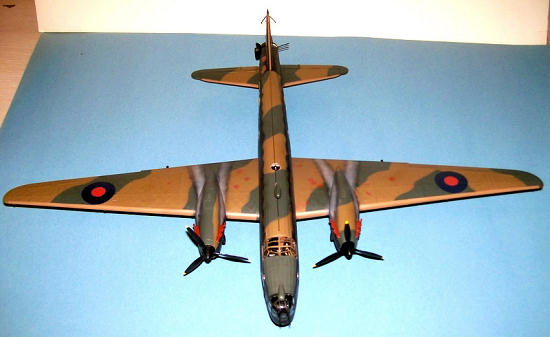 Offered a
job to help his fellow Poles to settle in the UK was a task that he happily
accepted. He taught them English and it was a very pleasing experience. Rafal
decided to emigrate to Argentina and when Jacek went to the Argentine Consulate
to start his papers he was asked for some money to speed up the process…and
therefore he decided not to try the Argentinean option…In 1947 he was offered a
Commission in the RAF. His postings as Air Controller included Singapore and
Malaya during the unrest of the early 50s, Preston in the UK and Nicosia in
Cyprus.
Offered a
job to help his fellow Poles to settle in the UK was a task that he happily
accepted. He taught them English and it was a very pleasing experience. Rafal
decided to emigrate to Argentina and when Jacek went to the Argentine Consulate
to start his papers he was asked for some money to speed up the process…and
therefore he decided not to try the Argentinean option…In 1947 he was offered a
Commission in the RAF. His postings as Air Controller included Singapore and
Malaya during the unrest of the early 50s, Preston in the UK and Nicosia in
Cyprus.
His travel with his brand-new sail ship from the UK to Cyprus is told in his book “Underwater Gorillas are Hard to Find”. In this island the unrest and war among Greek and between Greece and Turkey meant another spell under fire in 1974.
He traveled to Poland twice. During one of those trips he visited the neighborhood were he lived as a kid. Nothing was left from it. All was new as the old buildings had been destroyed during the war…either during bombings or razed by the Germans as revenge for the uprising. The only construction left was in fact…his family house. But now it stands as a memorial to honor 26 members of the AK killed in 1944 by the Gestapo who had used the Blocki’s house as the Headquarters of the criminal organization.
His medals include:
After retiring from the RAF in
1975 Hilda and Jacek settled in Cyprus.
After selling his boat he used the RAF boats at Akrotiri for many years.
Eventually he hired German boats in southern Turkey twice a year and took
friends sailing; his last sail was just over a year before he died.
Jacek passed away in 2010 at
age 88 in Cyprus. His son Michael, the Polish Ambassador and
Group Captain John Bessell, Station Commander of Royal Air Force
Akrotiri were among the ones who were present at his funeral. A fly past by an
84 Sqn rescue helicopter took place during the ceremony.
| THE KIT |
My jaw dropped when I opened the box. Presentation is excellent with all metal, clear and rubber tires held in another box inside the main one. All sprues are individually bagged. It is probably the most complex and complete kit I have tackled so far.
The Trumpeter kit has more
than 600 pieces. Quality has nothing to envy to Hasegawa and Tamiya. There is a
very complete interior and lots of armament (bombs) that in their great majority
will end up in your spares box. Decals are useless because the red lettered
codes were not introduced until MkIs were not in service anymore.
The conversion kit for a MkII
includes two Merlins with some little parts, two clear resin windows for the
fuselage, enlarged horizontal surfaces, 8 propeller blades, a blank for the
fuselage turret, two propeller hubs, four sets of exhaust stacks, a blanked nose
turret, and a very nice decal sheet with 5 options.
The 4,000 lb set has a Cookie (or blockbuster) bomb, the bomb bay doors and the cradle to be fit in the bomb bay.
| CONSTRUCTION |
There is lots of work to do in
the interior of the fuselage even though most of it will be lost once the halves
are glued together. Especially when the plane to be depicted had the long
fuselage windows painted over in black.
I first started cutting out
the holes for the triangular windows on the fuselage. Using the directions in
the Alley Cat set and following the internal structure it was a simple task. I
left some thinned fuselage plastic on the edge of the opening to be used as
support for the windows (these would sit on the thinned out area).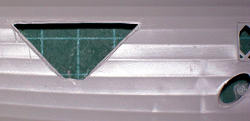
I put together the pilot
office with the intention of painting it in black once assembled. Luckily,
before painting it, I happened to reread Jacek’s book and he clearly states that
Z8343 was a single (not a double) seat Wellington. Now that the control column
and other parts were in place I had to cut out the right hand side very
carefully. With this done the office was sprayed in black.
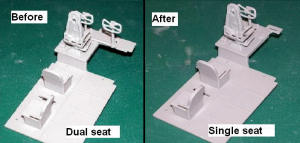
The navigator and radio
operator compartments were mostly made of wood. Those walls and bulks I painted
first in medium brown. Originally I thought about using the technique I had used
for Pattle’s early Gladiator. That is to say once the light brown paint was dry
I would apply clear dark brown varnish and then remove it with cotton. But I was
lazy and decided to reverse the base and first give a hand of darker brown and
only then a lighter tone of brown. When 10 seconds or so later I removed the new
color using a damped cloth I was surprised to find that the edge of the lighter
brown had already dried out so it was not removable with the cloth anymore. But
this left a very nice effect of marbled brown, the same one you find in cut
wood. I repeated it in other parts with great success. The longer you let the
paint sit the thicker the light color edge is going to be.

Most of the framing I painted
in aluminum. The fuselage floor in light gray and the path on top of it in black
with some very diluted light brown drops to resemble the wood underneath the
black paint, coming out due to wear and walk of the crew.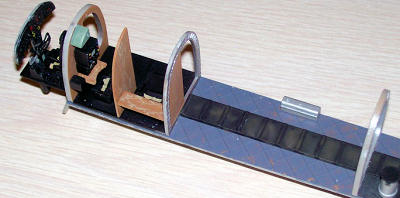
Following the excellent
pictures found in Wellington (4+) I painted the radio and the instrument panel
with drops of Future to depict the instrument faces where needed. It is the
first time I use the acetate one as supplied with the kit. A beauty. Great to
work with, excellent finish and detail. Sadly it cannot be seen once the cockpit
is closed…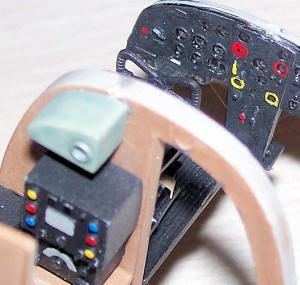
I took some seat belts from the Airwaves RAF set and added them to navigator, radio operator and pilot seats.
Carefully I attached the masked fuselage windows and proceeded to blend them with the fuselage using putty and wet sandpaper of various grits.
The oxygen bottles received a coat of black and RAF interior green for the braces. Other details for the fuselage included the chemical toilet, the flares launcher, the extra oil tank, the rockets (orange), the blue W/T trailing aerial winch, parachutes in black, ammo boxes and rails, bombing computer and radio.
With a mix of red and brown I
made up the dope color for the fabric. This paint stretched the fabric once it
dried. The internal side of the fuselage received a hand of this color. The tail
turret, bomb bay area and front fuselage areas received a coat of black.
The internal fuselage framing
was painted in silver, frame by frame, using a brush.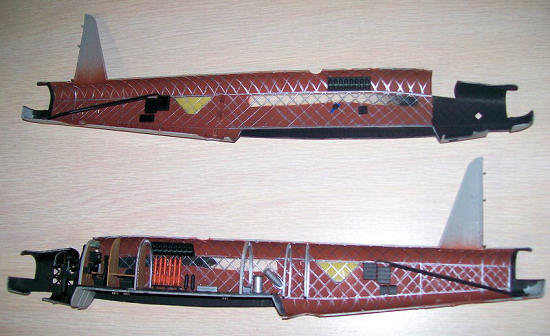
The camera received a couple of drops of Future as “glass”.
Both turrets were put together. They are excellent and
have lots of detail. I added seatbelts here. I decided to glue the tail turret
facing one side (thus leaving the doors open to see the details) and the nose
one almost pointing straight to the front but with the doors open to get some
more light inside the fuselage…if that is possible! I masked the Plexiglas and
gave the external part of these turrets a coat of matt black. After removing the
masking tape of the parts of the turrets that would end up inside the fuselage,
I attached the opened doors to the front turret.
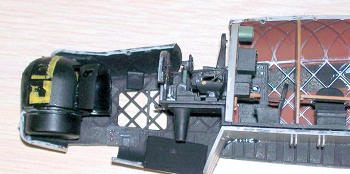
I removed the supports for the bomb bay (at the center) in order to accommodate the cradle for the Cookie.
After some cleanup I attached
the cover for the ventral turret and the housing for the tail wheel (both
painted in black)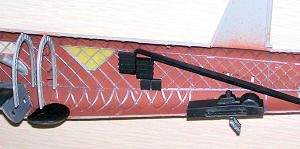
I glued all the internal pieces (including the opened to port crew access door) and when done, after taking some pictures to remember all the hard work I put on the interior, I proceeded to glue the two halves together. This was easier said than done as the front turret would not fit easily and trended to open up the top front of the fuselage. So in preparation I had to dry test the fit many times, sanding some fuselage areas and thinning them down in order for them to accept the turret. I managed to close the two halves but still had to add some putty and do some sanding especially in the area of the front turret fairing.
The downward ID light under the nose is a single clear piece. After adding putty and sanding the area the surface had a much better fit and match. As most of the support is black a tiny ball of Blue Tac covered the clear round portion to represent the glass for the light.
There was a little bit of putty required here and there but it was minimal.
Attention then moved to the wings and the landing gear. I did not find the problems mentioned by Tom Cleaver in his build. The etched parts went together very well…though I followed his advice and made sure that all the holes were properly opened up. I sprayed the interior in black, glued the two wheel wells plastic halves together.
I decided to build the plane
with the flaps up as all the pictures I have seen in my 3 references don’t show
these in the down position. I had to sand some of the top corners of the landing
gear wheel wells for the upper and lower halves of the wings to close properly.
Once this was accomplished I had to use some putty to improve the unions.
Next the Alley Cat Merlins.
These require little work to clean them up but due to (most likely) my building
skills they don’t have a very clean match to the engine housing on the wings.
With a Goop
mix (Goop – Plumber’s weld) I
filled up the gaps and sanded the plastic a little bit to get both surfaces
closer together. I did not lose lots of details and the ones I had sanded out
were easily rescribed.
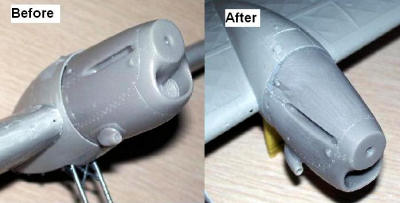
Even though there is a box
that should help you to attach the wings to the fuselage I found this part to be
somehow tricky and not as straightforward as described elsewhere. The wings move
around a little bit and thus some glue stuck on the “fabric”. Once the wings had
properly set I had to sand those stains of glue and use Tamiya putty and some
acrylic base white paste to fill in some of the gaps along the joint. Nothing
too serious though.
The next step was to attach
the horizontal tail surfaces. While cleaning the resin Alley Cat ones I found a
nicely rounded piece of resin on my table. Hmmm…! Odd I thought…then I tried to
dry fit the Trumpeter moveable surfaces and I realized that a little chunk on
the resin part was missing. It was the outermost actuator. And luckily I had
kept that nicely rounded piece just in case…because it was the missing actuator!
After a couple of failed tries I stayed in place. With the moveable surfaces
attached I proceeded to use superglue to mate the surfaces to the fuselage. Nice
and easy…except that the
 following
day, while trying to improve the joint with putty, both came off as if I had
glued them with white glue! Right! That is why Alley Cat says that superglue
should not be used…Instructions are there to be read and followed Pablo! I
resorted to my always friendly two part
and finally a very firm and easy
to sand and perfect union was achieved.
following
day, while trying to improve the joint with putty, both came off as if I had
glued them with white glue! Right! That is why Alley Cat says that superglue
should not be used…Instructions are there to be read and followed Pablo! I
resorted to my always friendly two part
and finally a very firm and easy
to sand and perfect union was achieved.
At last I attached the 4,000 lb bomb cradle in the bomb bay with the same glue.
I glued the canopy (previously masked) windows, attached the tail strut and masked some bits here and there (all the windows in the nose, bombing window, etc.) The tail turret opening was covered with BlueTac. The crew access hatch was masked with Tamiya masking tape.
With this I was ready to start
the laborious painting process.
| COLORS & MARKINGS |
There are two partial pictures of the left hand side of the plane in Jacek’s book. One shows him smiling with his head out of the pilot window; the other has him standing close to the “S” for Sugar. On these two pictures I was able to determine that those blurry lighter shapes are in fact dope paint (most likely repairs after the mission). I had also found several pictures of MkII planes from 305 Sqn but none of Z8343. Just by chance I found the London RAF Museum website and sent them an email asking them if they had a picture of this plane, explaining my distant political relationship with Jacek. Two days later they sent me a picture of the subject, showing 25 bombing missions on the tail, the area extensively repaired and the crewmembers beside the turret. Regretfully, after consultation with the family, it turned out that none of them was Jacek…but an invaluable and perfect picture of the plane was now going to help me to improve the accuracy of my model.
First step in the painting
process was again to mix red and brown to create dope paint. The entire model
was painted with this color, except for the engines, as these would have been
aluminum. The “S” in “SM” had also been retouched in the actual plane so I
covered one “S” with Blue tac leaving only a little round hole and sprayed dope
in that area.
Using the pictures as a guide
and the explanation found in the book regarding damage to the wings and fuselage
I used blobs of Blue Tac to mask the dope paint in order to represent the
repairs as seen in the pictures.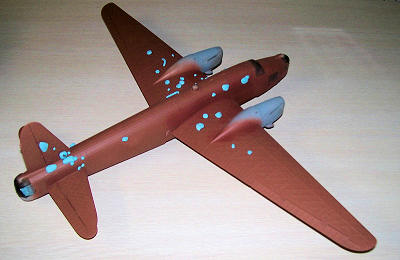
With Model Master Acryl RAF
Dark Brown I gave all the upper surfaces the first camo colour. I was able to
somehow determine the pattern of green after playing with photo editors, looking
at several pictures of planes from this squadron. The dark brown (that I had
toned down with white to give the colour some wear) was covered with paper and
masking tape. Model Master Acryl RAF Dark Green with a touch of white completed
the upper surfaces colour.
Exposing the leading edges of wings and vertical and horizontal tail surfaces I painted them with a mix of yellow and brown. This was the special paint applied in those areas to minimize the build up of ice. The pattern to be followed was found in the Alley Cat coloring schemes.
The next step was the not so
easy wavy demarcation of black and green/brown. First I tried to do this area
using Blue Tac. It was not very good at staying in place and also the pattern
was not as regular as seen in the pictures. After trying for a couple of hours I
decided to take a different approach. I took one picture of a 305 Sqn plane in
flight, eliminated everything except for the black areas using a photo editor
and took this wavy shape to scale. Then I printed it two times and cut it out.
This gave me enough length to mask the entire length of the fuselage. BlueTac
kept the paper away from the surface of the kit. All the green and brown areas
were masked with tape and paper.
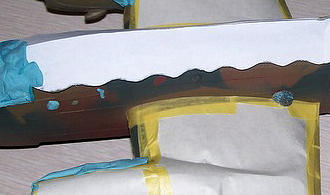
With very low pressure I
started to paint the demarcation line with the matt black (mixed with some drops
of white). Then I moved to safer areas like undersides of wings, fuselage,
propellers, propeller hub, cookie bomb and bomb bay. Another area that had to be
sprayed carefully with just black was the top of the tail
vertical stripes
as that was the case in this plane (in the actual plane this was done to add the
yellow bomb marks over a freshly painted black background)
When I removed the paper masks
I was very pleased with the results. There was no need of any retouch except for
some areas where there was a “ghost” line of cammo that had not covered the dope
colour. A little bit of Blue tac in those areas, very low pressure and
everything was ready for the next step.
I had to wear the paint a
little bit more. First, expose some more dope in the fuselage in the black area
as seen in the picture sent by the London Museum. To this I sanded dry pastels
(brick colour) and applied generously the dust using a brush. I blew the excess
off and repeated until satisfied.
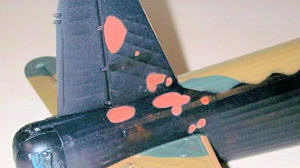
Aluminum drybrushed gave some depth to the honeycomb radiators located under the Merlins.
Having seen that most of the
MkIIs had considerable staining on the wings due to the Merlins I decided to
follow suit. My first approach in order to avoid using paint was to buy while
pastels, sand them and brush them on. Then black was applied as the edge. So
far, though the effect was a little bit too subtle, everything looked fine. I
applied a fine coat of Future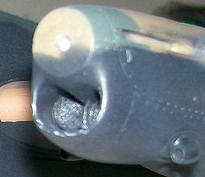 to protect the white pastel dust…and it disappeared! No white left! Nowhere!
Back to square one and now needing to find a better system…I decided to give it
a shot using Matt Varnish and some drops of white. I tried on an old model I
have that is all full of different painting tests. I added more white paint
until I was surprised that I was able to achieve a decent look with different
degrees of intensity, as it would happen in the actual planes where the stains
would be more marked close to the exhausts and less towards the trailing edge of
the wings. I masked the areas of the wings adjacent to the stains to prevent an
“accident” (that is to say, over spraying an area that was not white and then
needing to spray again brown or green…) Taking a deep breath and being extremely
cautious I applied my mix and build it up. It was not that hard at all and with
more confidence I did the other 3 exhausts. The black pastel stains were not
covered and a very nice effect was achieved.
to protect the white pastel dust…and it disappeared! No white left! Nowhere!
Back to square one and now needing to find a better system…I decided to give it
a shot using Matt Varnish and some drops of white. I tried on an old model I
have that is all full of different painting tests. I added more white paint
until I was surprised that I was able to achieve a decent look with different
degrees of intensity, as it would happen in the actual planes where the stains
would be more marked close to the exhausts and less towards the trailing edge of
the wings. I masked the areas of the wings adjacent to the stains to prevent an
“accident” (that is to say, over spraying an area that was not white and then
needing to spray again brown or green…) Taking a deep breath and being extremely
cautious I applied my mix and build it up. It was not that hard at all and with
more confidence I did the other 3 exhausts. The black pastel stains were not
covered and a very nice effect was achieved.
With a silver pen I chipped paint here and there to represent some wear and the opening and closing of panels.
After all these sessions I
finally gave the plane two or three coats of Future. Slowly building it up,
starting from the bottom and moving to the sides and finally ending on the top
of the plane. As I have discovered with my 164 Sqn Spitfire, it only took
patience to achieve a very nice (and not runny) finish.
There are no stencils so the process of applying decals was quite fast. I applied all the roundels first and the tail bars and helped them with Sol. Once they had dried up the next day I started with the “SM”s and I realized that I had painted one of the dope “fixes” in a spot where one of the letters on the left side of the fuselage was going to sit. The day after the decal had dried I drybrushed some dope and perfected the smooth edge using sanded pastels, following the original stain I had painted days before.
During the picture hunt I
realized that I did not have 50 bombs of the correct size to be applied to the
tail. I sent an email to Alistair (at Alley Cats) and he sent me (for a small
price) another copy of the same set supplied with the MkII conversion. When I
did some extra measurements I found out that these were not at the distance
required for Z8343 so I proceeded to cut each bomb individually and place them
carefully closer together. This process was repeated on both sides.

I added the Polish checkered markings and the
individual “S”s for Sugar.
Using the picture of the tail section I cut out parts of the serial number and place them on the fuselage. To dilute the now sharp edges and represent the wear that had practically erased these numbers I used sanded black pastels and a brush.
The entire plane was given a coat of Matt clear varnish (Model Master Acryl) and left to dry for a couple of days.
| FINAL CONSTRUCTION |
Once the matt colour was dry all the red pastel stains and wear showed up again (they had disappeared under the coats of Future).
I removed all the masking tape from the clear surfaces…and with the tape came off most of the colors I had applied to the canopy frame and the triangular windows on the fuselage…! With patience, a small brush and holding my breath I carefully painted them again. The result was pretty good.
The rubber wheels went with no
problem on the hubs, and these were placed using some little metal rods supplied
by Trumpeter. Therefore the 3 of them rotate with no problem.
Next step was to add the
cookie bomb (with Goop). No problems here. I had previously painted in aluminum
the braces that hold the bomb in place. No bomb bay doors were attached (not
even the ones supplied by Alley Cat with their bomb) as Jacek clearly states in
his book that it was quite a challenge to take off with the “4,000 lb bomb and
no bomb bay doors”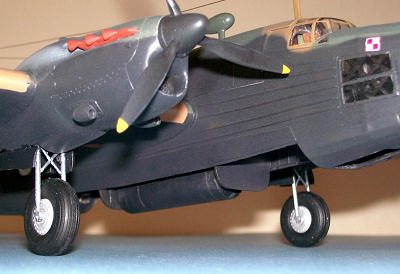
After painting the exhausts with Model Master Acryl rust (and black to represent the actual holes) I placed them using tiny amounts of Goop.
The right side propeller was
chipped with silver pen and sprayed clear matt. The left one, being a new one
after losing it in the mission, was painted in clear satin and I added no
chipping.
The antenna and the streamlined loop aerial were next (the last one covered in satin clear varnish as it was a metallic part)
The pipes for the fuel jettisoning system were painted in black and drybrushed with rust.
With a drop of silver I represented the formation light on top of the fuselage. The clear cover and astrodome went in with not a lot of fuss. Just some sanding of the clear parts and scraping of putty and paint off the fuselage.
The mass balances were added to the tail, including the photo etched one and then painted in their respective colours.
Formation lights on the rudder were painted in gloss white; the one on the nose in silver.
Painted in black the blind panel Venturi and the
trailing W/T trailing aerial tube wer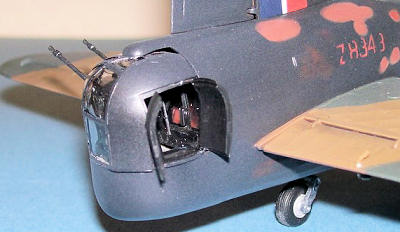 e
glued in place.
e
glued in place.
The photo etched “wire
cutters” demanded some careful handling (I lost one but made it from scratch
using the “tree”/frame of these parts) but went with practically no fuss in
their places on the border of attack of the wings.
The machine guns were inserted thru the front openings of the turrets and after some trials glued in place (after receiving a dry brush of aluminum to highlight some details). I glued the two tail turret doors.
And finally (!) after studying the 4+ diagrams for some time I added the two aerials using 0.010” stainless steel wiring.
| CONCLUSIONS |
This is my tribute to my distant relative. A World War
II hero.
| REFERENCES |
January 2012
If you would like your product reviewed fairly and fairly quickly, please contact the editor or see other details in the Note to Contributors.